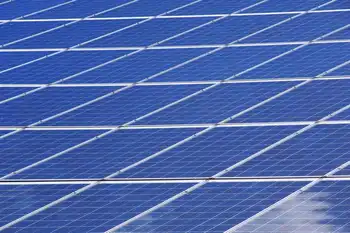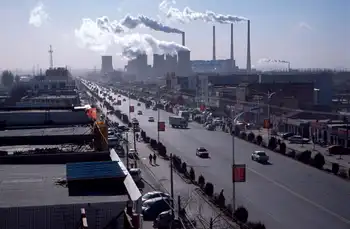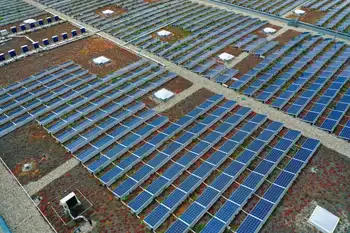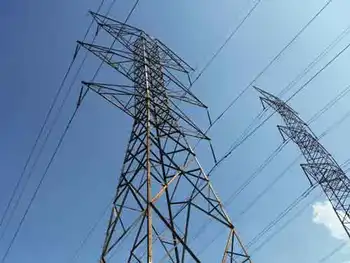The long road to an alternative-energy future
Just don't expect them anytime soon.
Why the delay? After all, the computer revolution has shown how rapidly new innovations can be imagined, developed, brought to market and have an impact. But new energy technologies don't work that way — they can take years to gain just a toehold in the market, and 20 to 30 years to push aside existing products or techniques.
That's partly because of the sheer size of the energy market. Global power consumption is estimated to total 150 trillion kilowatt-hours in 2010. The utility industry in the U.S., the most energy-hungry nation on the planet, produced an estimated 3.7 trillion kilowatt-hours of electricity in 2009. Nearly half of that was produced by coal, while solar power contributed less than 0.1%.
Wind power is one of the fastest-growing sources of renewable energy in the world. But by the end of 2008 there were still only 121.2 gigawatts of generated capacity — representing around 1.5% of global electricity consumption.
Of course, no single technology needs to replace all that carbon-producing power. Researchers planning for future energy supplies are working on several technologies simultaneously, including carbon capture to produce electricity, and next-generation biofuels and electric-powered cars to move us around. They talk about the need for "silver buckshot," instead of a silver bullet.
Researchers also agree that policy makers can speed or delay these developments — at least up to a point. A price on carbon, either through a tax or a carbon-trading mechanism, would make new technologies competitive with cheap oil and coal more quickly, spurring investment in and adoption of alternatives. Governments can also spend money on research, development and pilot projects, speeding the move from the drawing board to the market. Higher oil prices also make all the energy alternatives more attractive to investors and consumers.
But even if you combine all the current alternatives, they aren't likely to make much of a dent for quite a few years. To better understand why, we offer a closer look at a handful of the most-promising clean-energy alternatives, and the reasons they'll be a long time coming.
New Nuclear Reactors
THE TECHNOLOGY: Advanced nuclear reactors use simplified, standardized designs that should be cheaper and quicker to build and easier to operate. Passive safety features lower the risk of accidents.
These "generation 3+" reactors consume more of the nuclear fuel, lowering operating costs and trimming waste. Looking ahead, some generation IV designs can recycle used nuclear fuel, producing even less waste and relying less on new uranium supplies.
CURRENT STATUS: About a dozen generation 3+ reactors are being built around the world, and more are planned, including nearly two-dozen in the U.S. awaiting certification and licensing by the Nuclear Regulatory Commission.
For generation IV reactors, an international group of scientists and researchers is coordinating research and development, and they've agreed to a list of six technologies to pursue.
WHY IT'S GOING TO TAKE SO LONG: While China and France, among others, are moving ahead with construction of the generation 3+ reactors, the first new plants in the U.S. aren't likely to appear until late in the decade; NRC certification of the new designs may not occur before early 2012, and construction, even if accelerated, will take at least four or five years.
Even in France, Europe's most enthusiastic devotee of nuclear power, a third-generation plant at Flamanville in Normandy, which is intended as a prototype for up to 40 others, won't be completed until late 2012.
Generation IV reactors aren't expected to enter commercial development until after 2020. In 2006, France started funding prototype fourth-generation, sodium-cooled fast reactors. But the technology will not be ready for industrial deployment until after 2035 at the earliest.
Carbon Capture and Storage
THE TECHNOLOGY: Carbon-capture technology pulls carbon dioxide from the smokestacks of coal and other fossil-fuel plants, pressurizes the gas and pumps it underground for permanent storage.
CURRENT STATUS: A handful of small-scale carbon-capture and storage pilot and demonstration projects are under way around the world. In a test to capture CO2 from an operating power plant, American Electric Power Co. is running a pilot at its Mountaineer plant in West Virginia, collecting about 1.5% of the plant's CO2 emissions and storing them under the site. Other sites in Europe, Africa and Australia are investigating underground storage, but Mountaineer is the first to integrate capture and storage.
Work has also begun on a carbon capture and storage test power plant at Schwarze Pumpe in Germany. It will be used to test oxy-combustion, which generates purer carbon dioxide that is easier to capture and store.
WHY IT'S GOING TO TAKE SO LONG: Technically, carbon capture has been shown effective in small, less expensive pilot projects. In capturing larger emissions streams, operators have to fine-tune the equipment and see how it works in different weather conditions and using different grades of coal. In a test at AEP's Mountaineer plant, this stage is expected to take at least a year.
Once that is done, the next stage is building and operating a commercial-scale demonstration plant. AEP recently received $334 million in U.S. government stimulus funds for its planned 235-megawatt demonstration plant. AEP expects that power-plant builders could begin offering commercial versions of the technology by 2020.
The Schwarze Pumpe facility in Germany is also only a prototype for a prototype. Eventually, larger demonstration plants will be built in Germany and Denmark, but not until 2015.
Earlier this month, the European Union agreed to provide as much as $13.6 billion in funding for carbon-capture trials but does not believe the technology will be commercially available until 2020.
Ultimately, commercial adoption will depend on whether governments decide to impose a price on carbon and what that price is. Carbon capture is expensive — it could double the price of electricity from some existing coal plants, and cuts plant efficiency by about 30%.
Most experts agree that it is going to take a carbon price of at least $50 a ton for carbon capture to become economically feasible.
Algal Biofuels
THE TECHNOLOGY: Algae are fast-growing, consume carbon dioxide and have the potential to produce more oil per hectare than other biofuels. The oils they produce can be used to make substitutes for diesel fuel, aviation fuel and gasoline.
CURRENT STATUS: About 150 companies world-wide are working to commercialize algal biofuels. U.S. government support has soared in the past few years; the Energy Department recently granted $44 million for research into commercializing algal biofuels and $97 million for algae pilot and demonstration projects.
In the biggest project, Sapphire Energy of San Diego, Calif., plans to break ground on a 300-acre (121- hectare) biorefinery in New Mexico later this year.
Another recipient, Solazyme Inc., uses a fermentation method to produce algae-based fuels and has contracts to provide the U.S. Navy with 1,500 gallons (5,678 liters) of jet fuel and 20,000 gallons of diesel to power navy ships; the company is converting a plant in Pennsylvania into a demonstration biorefinery. Big oil companies, including ExxonMobil and BP, have invested in algae-biofuel projects or companies.
European support for biofuels has oscillated wildly. The European Union originally imposed a compulsory 10% quota of biofuels in all petrol and diesel by 2020 but came close to scrapping this amid concerns it would jeopardize food production. The focus has shifted to sustainable biofuels — a likely boon to funding for algal biofuels, according to experts.
WHY IT'S GOING TO TAKE SO LONG: As promising as the technology is, it hasn't proved that it can produce fuels in sufficient quantities or at a low enough cost to make a dent in global liquid-fuel consumption. Solazyme's fermentation method, which grows algae in dark, enclosed tanks, is considered by some experts to be closest to maturity; the company expects to reach commercial-scale production by 2013.
Wind
THE TECHNOLOGY: Wind power is one of the fastest-growing alternative energy sources in the world — a low-carbon, renewable source of electricity that can deliver millions of watts of relatively low-cost power.
CURRENT STATUS: Seven of the world's 10 largest markets for wind-powered electricity generation are in Europe, which accounted for 54% of the world's total installed wind capacity at the end of 2008. In the U.S., wind produced about 73 billion kilowatt-hours of electricity last year, about 2% of total generation and enough to power about 13 million homes. Industry capacity rose nearly 10,000 megawatts, or 39%, last year to a total of about 35,000 megawatts.
Plans for the Beauly-Denny line, a backbone of pylons to carry electricity from wind farms in the Highlands of Scotland to the more densely populated parts of the U.K., were conceived in 2003 but have only just gained approval.
WHY IT'S GOING TO TAKE SO LONG: It may not. Wind power capacity in Europe is expected to increase by roughly 9% a year until 2030. In the U.S., the Energy Department laid out a scenario for how wind could meet 20% of the nation's total electricity demand by 2030 — about 300 gigawatts — displacing half of natural gas-powered and 18% of coal-fired generation. But a recent report by the National Renewable Energy Laboratory, or NREL, found that the Eastern U.S., which isn't blessed with substantial onshore wind resources, could hit the 20% target by 2024.
Still, reaching that goal is going to take significant investments in new transmission lines, especially in a transmission "superhighway" to carry electricity from parts of the U.S. with lots of wind to places where demand is highest. The NREL study estimates the price tag could be as high as $93 billion.
Local opposition to transmission lines can also present a challenge, especially when lines have to cross state lines. And hitting the U.S. goal also may require significant additions of offshore wind power, which the Energy Department predicts could deliver about 17% of its projected 2030 total. Offshore wind generation promises more reliable power. But it's about twice as expensive as onshore wind power.
Solar
THE TECHNOLOGY: Energy from the sun can be used to make electricity directly with photovoltaic panels or indirectly using concentrated sunlight to heat a liquid, which produces steam to turn electrical turbines. Concentrating solar plants can be built to store heat and deliver power for several hours without sunlight.
CURRENT STATUS: Total capacity — the amount of power that could be produced if the sun shone constantly — of solar photovoltaic systems has been nearly doubling every two years in both the U.S. and Europe, and the pace of increase is expected to rise further.
In the U.S., the estimated 2,000 megawatts of solar capacity in 2009 was nearly 45% higher than in 2008. That includes about 980 megawatts of concentrating-solar projects; an additional 81 megawatts are under construction. In the EU, there was an estimated 9,530 megawatts of solar capacity in 2008, up from 4,940 megawatts in 2007.
WHY IT'S GOING TO TAKE SO LONG: Even at that rate of growth, solar power is still minuscule: Solar generation in 2009 accounted for less than 0.1% of total electricity production in the U.S. Solar capacity remains less than 1% of the total.
"The biggest obstacle is that we're starting at such a low level," says John Benner, a research manager at the U.S. National Renewable Energy Laboratory.
In Europe, nearly 92% of total solar power capacity is accounted for by just Germany and Spain. Spain alone more than quadrupled its photovoltaic capacity between 2007 and 2008. This surge has been driven by government incentives that have yet to be matched in the rest of Europe.
The cost of solar installations has fallen in recent years, but remains high, partly because demand continues to keep pace with supply. And like wind farms, utility-scale solar photovoltaic and concentrated-solar projects also require additional transmission connections.
Electric Vehicles
THE TECHNOLOGY: In theory, electric vehicles could replace most gasoline-powered cars and light trucks. They can run entirely on battery power, or in the case of plug-in hybrids, on batteries that can be charged by a separate gasoline engine when needed as a backup.
CURRENT STATUS: About 56,000 electric vehicles are in use worldwide, but the numbers are deceiving — most are limited to low-speed driving and have limited range. So far, Tesla Motors Inc.'s Roadster is the only open-road electric vehicle in the U.S., but a handful of other all-electric cars, including Nissan Motor Co.'s Leaf, are expected to come to market in 2010. The first commercial plug-in hybrids, led by General Motors Co.'s Chevy Volt, also are slated to be available later this year.
In Europe, there is a wider range of models, including Reva's G-Wiz, the most popular electric car in the UK. Later this year, the Mitsubishi iMiEV, the first electric offering from a mainstream manufacturer, will be launched in Europe.
WHY IT'S GOING TO TAKE SO LONG: The biggest obstacle is cost. The advanced lithium-ion battery pack that powers the Volt, which can travel 40 miles (64 kilometers) on a charge, can cost as much as $10,000, though prices are expected to fall as production ramps up. The U.S. Energy Information Administration predicts that in 2030, the added cost of a plug-in hybrid will be higher than fuel savings unless gasoline costs around $6 a gallon (3.78 liters).
Another challenge is the need for public recharging stations. Most American drivers travel fewer than 40 miles a day. For European drivers, the average is even lower. This is well within the range of first-generation electric vehicles, but consumers will balk if they worry about running out of juice. Charging networks are scheduled to be rolled out over the next two years in Denmark, Israel and Portugal in cooperation with national power companies and supported by governments. Similar projects are planned in the U.S., Canada and Australia.
Public charging spots are less important for plug-in hybrids, which are more likely to be recharged at home. Still, owners may need to upgrade their existing outlets to recharge more quickly. A 240-volt outlet, which can charge an electric vehicle in about three to six hours, generally requires adding a circuit to the home's electric system to handle the additional load.
Related News

Explainer: Europe gets ready to revamp its electricity market
STOCKHOLM - European Union energy ministers meet on Monday to debate upcoming power market reforms. Brussels is set to propose the revamp next month, but already countries are split over how to "fix" the energy system - or whether it needs fixing at all.
Here's what you need to know.
POST-CRISIS CHANGES
The European Commission pledged last year to reform the EU's electricity market rules, after record-high gas prices - caused by cuts to Russian gas flows - sent power prices soaring for European companies and citizens.
The aim is to reform the electricity market to shield consumer energy bills from short-term…





